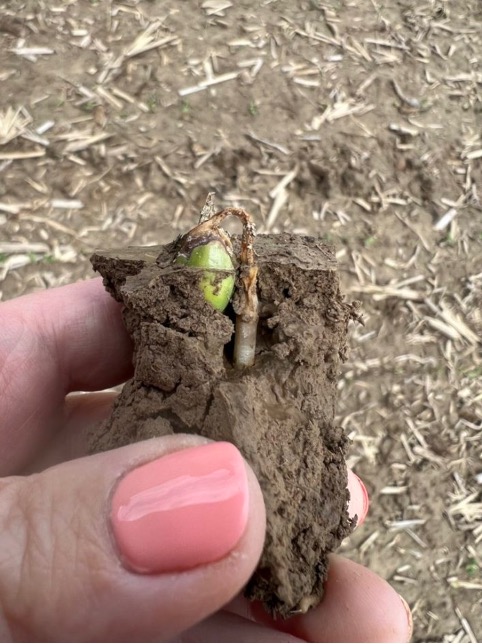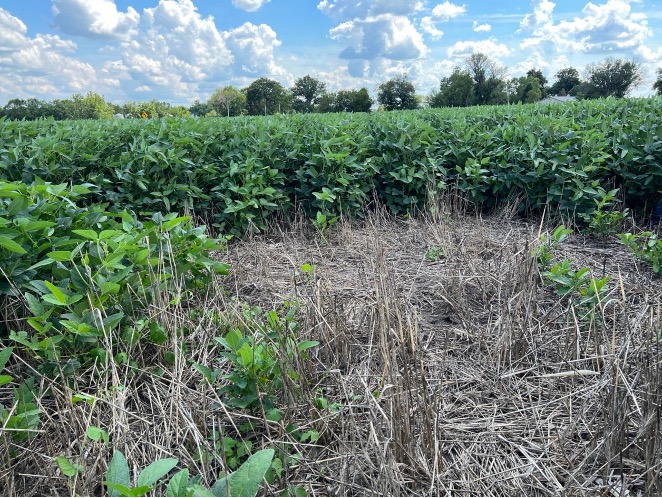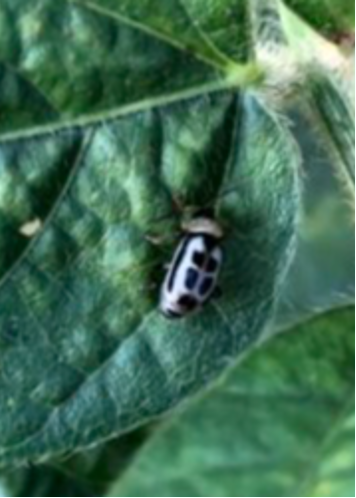Weeds

(Stephanie Porter)
The goal is to get high yield soybeans and to do this, we need to kill any “unwanted” plant that could rob potential yield. First, start out with a clean field. Pre-applied residual herbicides that are soil applied are needed to continue to stop millions of amaranth (waterhemp) seeds as they germinate. Unfortunately, the residual or Group 14 (PPO inhibitor) herbicides can come with baggage, especially if closely applied to emerging soybeans during cool, wet weather in certain soil types. In these situations, early stunting or possible stand loss could occur. In many cases, the injury or burn may look worse than one might expect, but always evaluate the stand. A good stand is also needed for adequate weed control throughout the season. Check with your seed company to see what your soybean variety’s tolerance is to PPO inhibitor herbicides. Others may recommend applying soil-active herbicides a week to 10 days ahead of planting, but this is easier said than done. Ultimately, these pre residual soil herbicides do a good job at keeping weeds at bay and away.
Voles
Voles have become a common pest as many have integrated cover crops into their soybean system. The number of voles is going fluctuate from year to year due to many factors such as mild winters, but on average, some could see 15 to 45 voles per acre and even up to 600 per acre along with extensive crop damage. Some farmers have a handle on their vole population, but if you don’t, scout before you plant. If you find 4 to 5 vole colonies living among your soon to be soybean field, you could be in for some trouble. When combating voles, you should either terminate your cover early to eliminate food and shelter or plant green to give those voles something else to eat. When planting, make sure that your seed slot is shut and that soybeans are planted 1.75 to 2 inches deep. If this is not the case, your row is an open smorgasbord for voles. Keep a close eye on field up to 28 days after planting or until soybeans reach 6 to 10 inches tall as this is when plants will be most vulnerable to vole damage. Don’t forget to also mow near fields. Repellents and baits are available, but they could be costly, and their effectiveness may vary.

Slugs
Slugs can be a major pest when planting into cooler and wetter conditions, especially in no-till or cover crop fields. Soybeans can be more vulnerable to slugs because their growing point is above ground, and it can be damaged. First and foremost, make sure the seed slot closes when planting. If not, the slugs will have an easy way to eat seeds. If possible, find ways to help that soybean out of the ground as quickly as possible by some pop-up fertilizer or a good variety vigor score. Slugs are nocturnal and feed at night, so they may be hard to find, and injury can be confused with other pests. Unfortunately, when it comes to injury, we don’t have any thresholds to tell us when to treat slugs. Insecticides don’t control slugs and there has been some evidence that neonicotinoids may increase slug feeding. There are baited pellets labelled for mollusks. Planting green or having other foliage for them to feed on may help, but this situation could eventually create favorable conditions for them to thrive. Again, soybean stands need to be evaluated and future environmental conditions should be taken into consideration with replanting. The good news is that once temperatures go above 80F, slug populations will significantly be reduced.

(Stephanie Porter)
Bean Leaf Beetle
Bean Leaf beetle is one of the first pests to emerge from wood lots or residue and their numbers could be higher this year thanks to a mild winter. They are hungry and go to the first or early planted fields to feed and there is no known resistance to bean leaf beetle within soybean varieties. If your seed treatment already consists of an insecticide component, then you have “insurance” against this pest. If not, different states have developed thresholds for bean leaf beetles such as more than 30% defoliation before bloom (Illinois) or 2 to 4 beetles per plant at VC/V1 (Nebraska) and an insecticide rescue treatment may be warranted. Soybeans can tolerate a lot of bean leaf beetle feeding, and often an insecticide treatment is not recommended, but we do become concerned if the bean leaf beetle vectors and infects soybeans with bean pod mottle virus. This virus can cause many different symptoms such as mottling, stay green, delayed maturity, and yield loss.
Grubs
Last, but not least, grubs could be an emerging pest of soybeans because May/June (2-to-3-year lifecycle) Masked Chafer or Japanese beetles (1 year lifecycle) will lay their eggs in grasses. If overly concerned, check your field for grubs before planting. You might also realize the number of grubs in your field as birds divebomb for grubs as they follow the planter in the field. If there are 2 or more May/June beetle grubs per cubic foot of soil, this signals a problem. Japanese beetle larvae may be more of a problem in early planted soybean fields. If you start to see wilted soybean seedlings, plants that have failed to emerge, or gaps in rows, then start digging and search for grubs. Unfortunately, there are no insecticide treatments that are labeled to be used at soybean planting and there are no effective rescue treatments to be used after planting. Seed treatments with insecticide treatments help to protect against white grubs but may not be enough to protect soybean stands. Replanting can be a tricky situation, especially when May/June beetles remain in the larvae stage in your field for 2 years. If you continue to have problems, you may want to identify the type of beetle by examining the hairs on the larvae raster (or bum). Check with your favorite Illinois Soybean Agronomy team if you need help.



 and then
and then